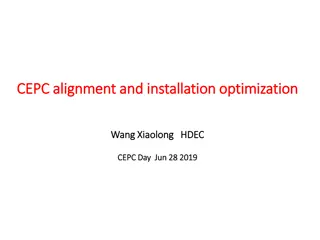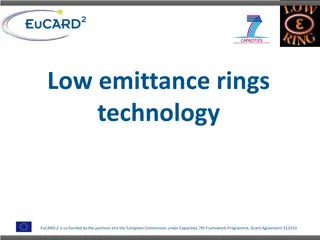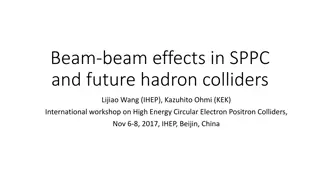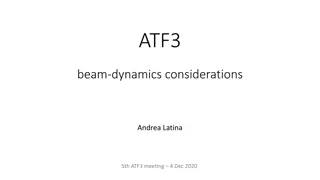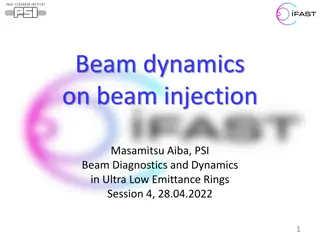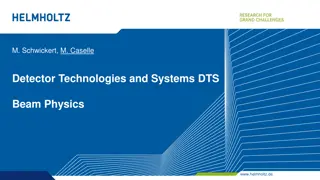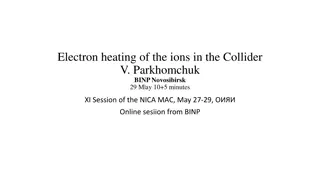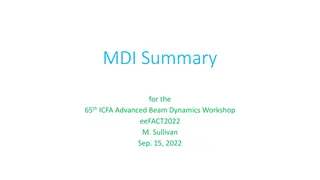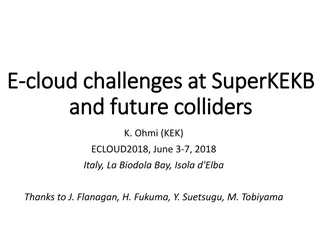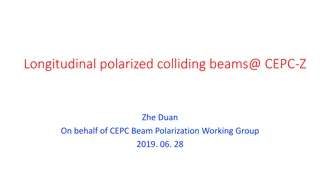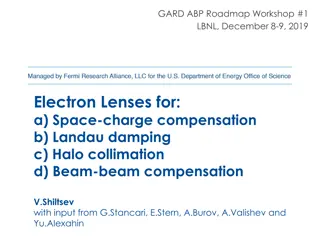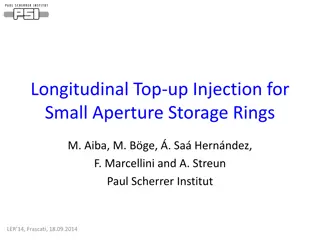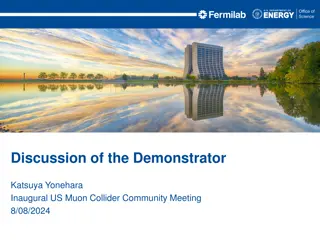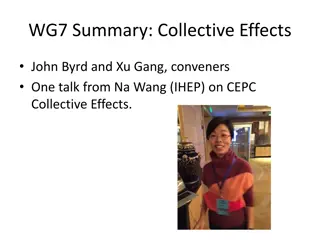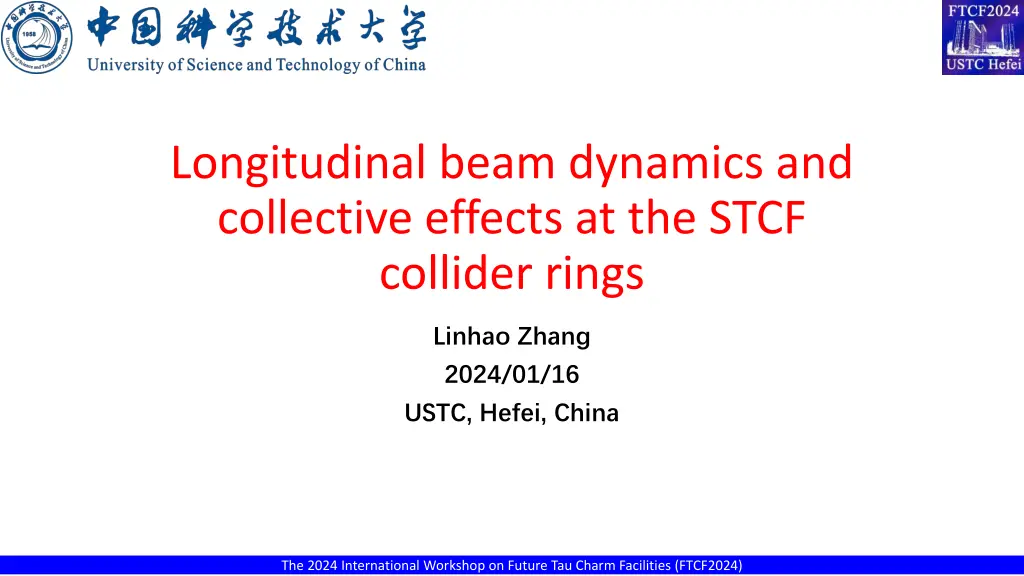
Longitudinal Beam Dynamics at STCF Collider Rings
Explore longitudinal beam dynamics and collective effects at the STCF collider rings presented by Linhao Zhang at the 2024 International Workshop on Future Tau Charm Facilities in Hefei, China. Learn about the key parameters, requirements, and design considerations for the Super Tau-Charm Facility proposed in China, focusing on achieving high luminosity with innovative collision schemes and beam properties.
Download Presentation

Please find below an Image/Link to download the presentation.
The content on the website is provided AS IS for your information and personal use only. It may not be sold, licensed, or shared on other websites without obtaining consent from the author. If you encounter any issues during the download, it is possible that the publisher has removed the file from their server.
You are allowed to download the files provided on this website for personal or commercial use, subject to the condition that they are used lawfully. All files are the property of their respective owners.
The content on the website is provided AS IS for your information and personal use only. It may not be sold, licensed, or shared on other websites without obtaining consent from the author.
E N D
Presentation Transcript
Longitudinal beam dynamics and collective effects at the STCF collider rings Linhao Zhang 2024/01/16 USTC, Hefei, China The 2024 International Workshop on Future Tau Charm Facilities (FTCF2024)
Contents Introduction Longitudinal beam dynamics Collective effects estimation Summary 2
Introduction Key parameters Requirements STCF (Super Tau-Charm Facility), proposed in China, is a new-generation super high luminosity e+/e- collider in the low-energy region Beam energy range 1 3.5 GeV (C.o.M energy 2 7 GeV) with optimum energy of 2 GeV Luminosity aims at 5 1034cm-2s-1@2 GeV 50 times higher than BEPCII Beam energy 1 3.5 GeV (Optimum energy 2 GeV) 5 1034cm-2s-1@2 GeV Luminosity Ring circumference 600 1000 m 1 mm at IP ?? Crossing angle 2 ~60 mrad 300 s Beam lifetime Collision scheme [1] To achieve such high luminosity, a large Piwinski angle combined with the crab-waist collision scheme is adopted Large makes interaction area length ??~ ?? ??? without hourglass effect However, large introduces unwanted betatron and sychro-betatron beam-beam resonance CRAB sextupole pairs with special phase advance and strength are innovatively used to suppress these resonance ? =?? ??tan? ?? ??? ??? ??? ~ ?? ?? ?? 1 ?? ?2? = ??? 3 [1] P. Raimondi, D. Shatilov, M. Zobov, Proceedings of 2nd SuperB Workshop, Frascati, 2006
Introduction However, the collision scheme will introduce a novel coherent beam-beam effect (coherent X-Z instability)[1], which imposes stringent constraints on the longitudinal beam dynamics requiring the horizontal beam-beam parameter ?xto be much less than the synchrotron tune ?z, i.e. ?x<< ?z On the other hand, STCF beam properties: low energy, low emittance(~5nm), high current (~2A) This means STCF faces significant beam collective effects Most of which relies on longitudinal parameters (bunch length z, energy spread , synchrotron tune ?z, etc.) The reason why we need to special design the STCF longitudinal beam dynamics which involves transverse dynamics, beam-beam effects, and collective effects, etc., in order to search for possible optimal solutions. [1] K. Ohmi, N. Kuroo, K. Oide, D. Zhou, and F. Zimmermann, PRL 119, 134801 (2017) 4
Contents Introduction Longitudinal beam dynamics Collective effects estimation Summary 5
Longitudinal dynamics design considerations Luminosity (take 2 GeV as an example) Vertical beam-beam parameter ??=?0?? 2?? Beam current I = 2A Beam energy 2 GeV ? = 3914.9 ?? ?? ???? 1 + ?2 ?0?? 2?? ????? ? =?? tan? ?? ??? ?? ? ? 1 ?? ?? ? = ? 2??? Luminosity reduction factor due to Hourglass effect ?? ???_? Electron charge: e = 1.602 x 10-19C Classical electron radius: re= 2.818 x 10-15m 2 2 ?? 2??_? ?? 2??_? ? = exp ?0 2 2 Lattice design ?? = 0.6 mm Effective bunch length ??_?= K0:0th order modified Bessel function ??? To achieve the high luminosity ( 0.5 1035cm-2s-1) at 2 GeV, the beam current of 2 A and ?? mm are first chosen, which poses a limitation on ??, and thus on ?? Note: Luminosity (almost) inversely proportional to ??(since ?? Additionally, it is noted that the time resolution at the detector requires ??not larger than 12 mm of 0.6 1 ??) 6
Longitudinal dynamics design considerations Coherent X-Z instability A newly discovered coherent beam-beam interaction under a large Piwinski angle using strong-strong beam-beam simulations primarily leads to an increase in the horizontal emittance ?x Considering the coupling between horizontal and vertical emittances, it eventually results in an increase in the vertical emittance ?yand a collapse of the luminosity This instability cannot be suppressed through beam feedback systems, but can only be avoided through appropriate parameter optimization Typically, a stringent requirement of ?x ?zis imposed to have wide region for the selection of working point without beam blow- up In the case of STCF, ?z/?x 3 is expected. SCTF case CEPC case 7
Longitudinal dynamics design considerations Lattice Design and Damping Wigglers Lattice design is crucial for achieving high luminosity by achieving the required optical parameters at IP and by optimizing nonlinear dynamics aperture Additionally, it defines the momentum compaction factor ?p and natural energy spread ? in the electron storage ring through synchrotron radiation integrals. These parameters (?p and ? ) are of importance in the longitudinal dynamics Damping wigglers are essential for STCF to control the damping time (30 ms) and to maintain beam emittance almost constant (~5 nm) throughout the entire energy range 1 3.5 GeV. This inevitably increases the synchrotron radiation energy loss per turn raising the demand for RF power This also increases the natural energy spread resulting in a proportional growth in bunch length The lattice including damping wigglers has been designed for STCF at 2 GeV 8
Longitudinal dynamics design considerations Non-impedance-induced collective effects Intrabeam scattering (IBS): multiple small-angle Coulomb scattering processes not immediately cause particle loss in the bunch but increase the equilibrium energy spread, bunch length, and transverse emittances Touschek effect: single large-angle scattering processes A large momentum deviation (beyond RF momentum acceptance or physical aperture) thus limit the lifetime of the stored beam (i.e., the Touschek lifetime) These two effects are directly related to the 6D phase-space size and thus associated with longitudinal parameters such as the bunch length elegant and SAD codes can be used to calculate IBS and the Touschek lifetime Impedance-induced single-bunch collective effects IBS Touschekscattering 3 3 ???? ?? ?z0 ?? ?z0 ? ? ? = Im bunch lengthening due to potential well distortion (PWD) 4 ???2?/? ?z0 eff 2????/? ? /?eff 4 ????/? ? Im? mwi=?? longitudinal microwave instability (LMWI) 2 ?? ?? ? tmci=?? transverse mode coupling instability (TMCI) ?? eff ? 9
Longitudinal dynamics design Longitudinal beam dynamics design for STCF requires iterative optimization considering transverse dynamics, beam-beam effects, and collective effects, in order to search for possible optimal solutions Input constraints Parameters defined by transverse dynamics Longitudinal dynamics design Optimization goals Prioritize goal 1 (Luminosity) and goal 2 (single-bunch instability) In fact, Touschek lifetime (Goal 3) relies heavily on the optimization of transverse nonlinear dynamics This is considered highly challenging for STCF 10
STCF STCF Parameters Units (wiggler+IBS) 2 616.76 60 3913.9 2.057 486.08 5.77 0.50% 28.85 40 0.6 15.19 0.132 31.552/24.572 31.552/24.572 (wiggler+IBS) 2 616.76 60 3913.9 2.057 486.08 5.66 0.50% 28.85 40 0.6 15.05 0.130 Longitudinal dynamics design Optimal beam energy, E Circumference, C Crossing angle, 2 Relative gamma Revolution period, T0 Revolution frequency, f0 Horizontal emittance, x Coupling, k Vertical emittance, y Hor. beta function at IP, x Ver. beta function at IP, y Hor. beam size at IP, x Ver. beam size at IP, y Betatron tune, x/ y Momentum compaction factor, p Energy spread, e Beam current, I Bunch train gap Number of bunches, nb Single-bunch current, Ib Particles per bunch, Nb Single-bunch charge Energy loss per turn, U0 damping time, x/ y/ z RF frequency, fRF Harmonic number, h RF voltage, VRF Synchronous phase, fs Synchrotron tune, z Natural bunch length, z RF bucket height, ( E/E)max Piwinski angle, ?P?? Hor. beam-beam parameter, x Ver. beam-beam parameter, y Equivalent bunch length, z_e Hour-glass factor, Fh Luminosity, L Touschek lifetime GeV m mrad ms kHz nm Single RF system, VRF=1.2 MV, z=0.0096, RF acceptance 1.58% ??= 8.18 mm ??= 0.0038 ??= 2.5 ?? ?y= 0.106, ? = 1.37 1035cm 2s 1 pm mm mm m m ??= 2.5??doesn t meet the requirement of coherent X-Z instability, possible mitigations: 1) Increase crossing angle 60 mrad 80 mrad ??= 0.0021 ??= 4.6 ?? ?y= 0.08, ? = 1.07 1035cm 2s 1 2) Modify lattice to increase ?? and ?? 3) Reduce RF voltage 1.2 MV 0.85 MV (RF acceptance 1.2%) ??= 9.81mm z=0.008, ??= 0.0026 ??= 3.1 ?? ?y= 0.090, ? = 1.15 1035cm 2s 1 All these measures need to be checked by beam-beam simulations Need to negotiate with MDI group 10-4 9.71 9.71 10-4 A 8.26 2 0% 514 3.89 5.00 8.01 286 8.26 2 0% 514 3.89 5.00 8.01 286 mA 1010 nC keV ms MHz 28.6/28.8/14.4 28.6/28.8/14.4 499.7 1028 1.2 166 0.0096 8.18 1.58 16.16 0.0038 0.106 0.51 0.8881 1.37E+35 >110 11 499.7 1028 0.85 160 0.0080 9.81 1.20 19.57 0.0026 0.09 0.50 0.8896 1.15E+35 >110 MV deg mm % rad The scheme adding a higher harmonic RF cavity to lengthen bunch is not considered here, since it will decrease ??while lengthening bunch more difficult to meet ?? ?? mm cm-2s-1 s
Single-harmonic RF system considerations Define the number of RF cavities from radiation power loss Synchrotron radiation power loss at 2 GeV is approximately 572 kW If BEPCII-type superconducting cavities are used, 2 cavities are required (assuming the highest transmission power for input couplers is around 300 kW) The number and power of BEPCII-type superconducting RF cavities required in the 1-3.5 GeV energy range need to be further determined after the completion of the parameter design in the entire energy range RF voltage distribution: At 2 GeV, the total RF voltage required for STCF is approximately 1.2 MV, so the voltage for a single cavity is around 0.6 MV Since the maximum voltage for a single BEPCII-type superconducting cavity can reach up to 1.8 MV, the maximum voltage for the two cavities can reach 3.6 MV (currently only using 1.2 MV), providing sufficient voltage margin for bunch length adjustment RF characteristics for the STCF: high power requirement, but not high total voltage different from SuperKEKB RF system, which requires high power and high total RF voltage Heavy beam loading 12
Beam loading driven by RF accelerating mode In a storage ring, the RF cavity needs to be detuned to compensate for the reactive component of beam loading, so that the power input from the transmitter to the cavity is minimized The optimal cavity detuning is: cos 2 c V Q For STCF at 2GeV, the optimal cavity detuning is -154.2kHz about 32% of revolution frequency f0(480.08kHz) f I R Refer to BEPCII superconducting cavity = r B f s Rs/Q0 Q0 fr Vc 95.4 0 109 499.7 MHz 0.6 MV Coupled bunch instability growth rate: I f ?+= ???+ ??0+ ?? ? = ??? ??0 ?? ( ) ( ) = 0 RF E e 1/ Re Z f Z f excitation mode + damping mode n l l 2 2 ( / ) Q s For n=-1 coupled bunch mode =3.6ms shorter than longitudinal radiation damping time 15ms Longitudinal couple bunch instability driven by RF accelerating mode (-1 mode) for STCF requires RF feedback -1 mode feedback system could refer to SuperKEKB or PEP-II The cavity detuning for B factories is equal to or even greater than revolution frequency f0, thus, longitudinal CBI caused by -1 mode is much severe than STCF 13
Contents Introduction Longitudinal beam dynamics Collective effects estimation Summary 14
Impedance-induced single-bunch collective effects Bunch lengthening due to potential well distortion (PWD) ? ?eff=0.1 (a typical value for 3 3 Assuming Im modern storage rings) then ??= 8.20mm 9.76mm Beneficial to ?x ?z ?z=??? ?z ???? ?? ?z0 ?? ?z0 ? ? ? = Im ? ???2?/? ?z0 eff Note: coefficient is 4 ?, not 2? [1,2] ?? ???? ?? ???2 2?? ?? [1] V. Smaluk, NIMA888, 22 (2018) [2] D. Zhou, G. Mitsuka, T. Ishibashi, and K. Bane, arXiv:2309.00808 (2023) Transverse mode coupling instability (TMCI) Longitudinal microwave instability (LMWI) 2????/? ? /?eff lmwi=?? 2 ?? ?? ? ? ? eff=2? eff= 13.96 k /m (Panofsky-Wenzel theorem) with b =37.5 mm, ?? = 42.5 m, then ?? than the design single-bunch current 3.9mA Ordinary vacuum chamber impedance will not cause TMCI However, further study is needed to determine if the addition of special components, especially collimators, will induce TMCI. Im? ?2Im Assuming the imaginary part of the raw impedance dominates the effective impedance, i.e., ? ?eff= 0.1 , then ?? Lower than the design single-bunch current 3.9mA Impedance optimization is a must! Further parameter optimization is also necessary tmci= 22.8 mA, higher mwi= 3.3 mA 15
Impedance-induced coupled bunch instabilities Longitudinal and transverse coupled-bunch instabilities induced by RF high order mode (HOM) ?????? 2(?/?)????? 1 ? 1 ? =?????0? 2?/? = Growth rate: ?s Assume that STCF adopts BEPCII superconducting cavity the main longitudinal HOM and transverse HOM (refers to KEKB SC) are assessed below: 2 cavities R ( /m) y (ms) 175 4823 24708 21366 370 341 R ( ) (ms) 275.9 10.0 1.95 4.5 130.5 142.0 697 15.0 127 75.8 157 53.6 111 73.2 141 46.8 Transverse damping time 30 ms Synchrotron radiation cannot damp transverse CBI driven by RF HOM. Transverse bunch-by-bunch feedback system is required Longitudinal damping time 15ms Synchrotron radiation can damp longitudinal CBI driven by RF HOM. 16
Impedance-induced coupled bunch instabilities Transverse coupled-bunch instabilities induced by resistive-wall impedance The image current induced by the relativistic beam on the walls of vacuum chamber with finite conductivity excites electromagnetic fields, acting on subsequent bunches, which can lead to development of instability mainly caused by resonant peaks in the transverse wall impedance at low frequencies Simple impedance model: cylindrical vacuum chamber 1 ? ? ?0???? 4??/? ? rw? = (sgn ? ?)? ?0??? ?3 = Re? rw(???) Growth rate: 2? ?= The most dangerous mode is n=487, corresponding to an unstable growth time of 0.94 ms Transverse bunch-by-bunch feedback system is required 17
Two-beam collective instabilities 3/2?? 1/2???? 3/2?? 1/2? 2???? ???? 3/2??+ ?? 1 ?? Fast beam instability (electron storage ring) Particle factory type accelerators (with high current and small size) have high ion yield and oscillation frequency due to the beam-gas interaction, resulting in instability occurring in a single turn Considering the spread of ion oscillation frequency, when the vacuum degree Pgasis 10-10Torr, the instability growth time is about 0.2 ms! Mitigation methods: 1) Transverse bunch-by-bunch feedback; 2) Large chromaticity = 5????(Torr) 1/2 ??? Electron cloud effects (positron storage ring) can cause coupled-bunch instability and single-bunch head tail instability STCF(2GeV) 0.02 0.33 Electron clouds at STCF are more serious than BEPCII, PEPII, KEKB Mitigation methods: 1) Antechamber beam pipe; 2) TiN coatings in vacuum chambers; 3) Solenoid fields in straight sections 4) Clear electrode in beam pipe 18
Summary STCF longitudinal dynamics at 2 GeV has been designed considering transverse dynamics, beam- beam effects and collective effects Single harmonic RF with total voltage 1.2MV (or less) basically enough Further iterative optimization is still needed, following the beam-beam simulations Main collective effects for STCF at 2 GeV was preliminarily estimated without impedance model (or with simplest impedance model) based on the ideal theoretical formula Detailed impedance models (or impedance budget) should be constructed Further simulations with impedance models are needed to study the collective instabilities Thanks for your attention! 19




